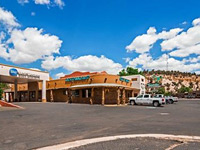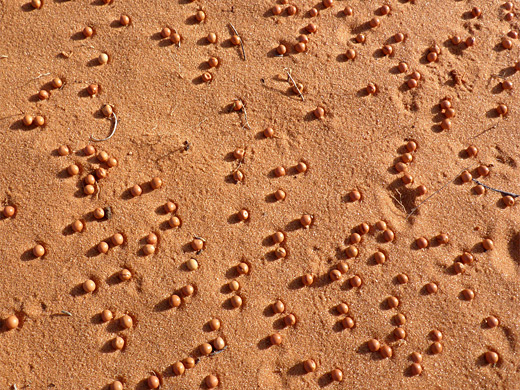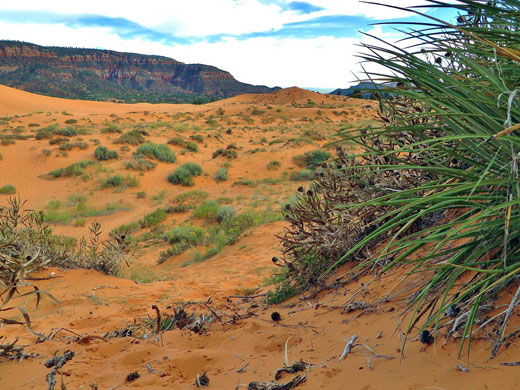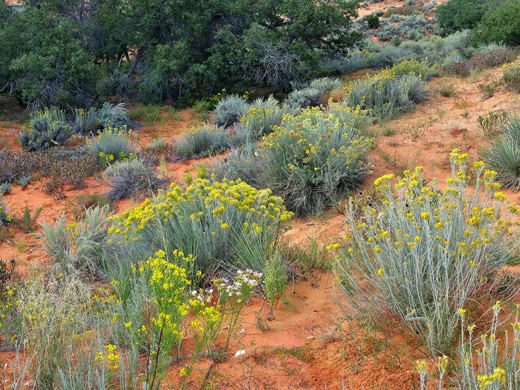Highlights:
Several square miles of shifting, orange-pink sand dunes formed by erosion from the nearby Vermilion Cliffs. Park has a campground and nature trail, and permits ORV activities on the dunes
Nearby town:
Mount Carmel Junction, 14 miles
Management:
Location:
Rating (1-5):
★★★★★
Seasons:
All year
Featured Hotel
Best Western East Zion Thunderbird Lodge
 Fully featured hotel in Mount Carmel Junction, at the US 89/Hwy 9 junction, beside a golf course and restaurant. 15 miles from the Coral Pink Sand Dunes
Fully featured hotel in Mount Carmel Junction, at the US 89/Hwy 9 junction, beside a golf course and restaurant. 15 miles from the Coral Pink Sand DunesCheck Rates
There is much sand in the rolling, juniper and pinyon pine-covered land around Kanab in the far south of Utah, colored variously orange, reddish or pink, all remnants of the Navajo, Wingate and Kayenta sandstone that forms the Vermilion Cliffs to the southeast. US 89 passes through the town and follows the upper end of Kanab Creek, climbs to a plateau at 6,000 feet then crosses an area known as the Sand Hills which has many square miles of bushy dunes and grassy plains, bordered by the White Cliffs to the north - a long escarpment running all the way to Zion National Park.
A more concentrated accumulation of light red sand is found a few miles south of the road, where a long strip of large, crescent-shaped dunes has formed in a depression beneath the Moquith Mountains, and the lower (southern) half is protected as the Coral Pink Sand Dunes State Park, established in 1963.
A more concentrated accumulation of light red sand is found a few miles south of the road, where a long strip of large, crescent-shaped dunes has formed in a depression beneath the Moquith Mountains, and the lower (southern) half is protected as the Coral Pink Sand Dunes State Park, established in 1963.
Coral Pink Sand Dunes Table of Contents
- Tours of the dunes
- Map of the state park
- Photographs
- The sand dunes; access and orientation
- The state park; facilities
- Nearby places
- Similar places
Tours of the Dunes
Map of Coral Pink Sand Dunes State Park

Photographs
12 views of the state park.
The Sand Dunes
The road to the Coral Pink Sand Dunes is a scenic drive that provides a handy short cut to the Arizona Strip district, and hence also a route west avoiding the fees necessary to pass through Zion National Park. Driving south from US 89, the great Navajo sandstone domes of the park are clearly visible, 15 miles away on the right, while a low mesa rises on the other side; in between, the road crosses the level grasslands of Clay Flat, followed by a shallow valley, Yellowjacket Canyon. The dunes appear to the east after 9 miles, just beyond a (paved) side road that leads back to US 89, and several parking places provide easy access to the sands which do look quite pink at sunrise or sunset but at other times seem more traditionally colored. They always present quite an impressive scene though, shapely mounds without any vegetation, spread out beneath tall, layered cliffs to the east. Like other sandy places in the Southwest such as Utah's Little Sahara Recreation Area and the Algodones Dunes in California, off road vehicles are allowed to roam freely, interrupting the tranquil atmosphere and spoiling the symmetry of the dunes with their tracks. So early morning is perhaps the best time to visit, as nightly breezes tend to smooth out the dune surfaces, and the ORVs are not permitted before 9 am.
The State Park
The official entrance to Coral Pink Sand Dunes State Park is few miles south of the northern edge of the dunes. The fee for day use (2024) is $10, which also gives access to a visitor center and nature trail, though there seems to be no need to pay if entering the dunes from one of the roadside parking areas. The park does have a small campground for an additional $25, and there are plenty of opportunities for free camping in the surrounding BLM land. Past the entrance, the main road continues south through pine woods; wide and still paved for a while, it becomes gravel and rather bumpy after the Arizona border, turns due east at the sleepy community of Cane Beds (an outpost of polygamism), then meets AZ 389 a few miles later. Vegetation within the park is understandably limited since much is barren sand, though there is one particular rare species found here, asclepias welshii (Welsh's milkweed), which flowers in June and July.
Coral Pink Sand Dunes - Nearby Places
- Sand Hollow State Park (24 miles) - red rocks, sand dunes and a reservoir
- Zion National Park (30 miles) - huge cliffs and sheer, narrow canyons
Coral Pink Sand Dunes - Similar Places
- Great Sand Dunes National Park, Colorado - large dune area beneath the Sangre de Cristo Mountains
- Monahans Sandhills State Park, Texas - active dunes of golden white sand
All Contents © Copyright The American Southwest | Comments and Questions | Contribute | Affiliate Marketing Disclosure | Site Map






